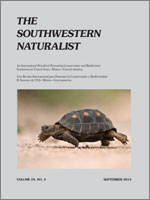Yellow rails (Coturnicops noveboracensis) winter along the U.S. coast, from North Carolina to Texas and southeastern Oklahoma. Although this rail is listed as a species of special concern in most of the provinces and states where it breeds, little is known about the winter ecology or population sizes of this secretive species. The goals of our study were to approximate numbers and determine age and sex ratios of yellow rails wintering in selected marshes at San Bernard National Wildlife Refuge (San Bernard NWR) in Brazoria and Matagorda counties, Texas. Yellow rails were banded in Spartina marshes from November 2009–April 2010. Feather samples were collected from each yellow rail for use in DNA sexing. We captured 170 yellow rails at the Cedar Lake Creek Unit of San Bernard NWR and recaptured 17 rails over the course of the study. We estimated that the population in marshes we sampled at San Bernard NWR (224.6 ha) from late November through mid-April consisted of 1,170 ± 300 individuals, or 5.2 ± 1.3 rails/ha. The highest ranked POPAN models suggest that the probability of recapture and the probability of entering the population were both time-dependent, while the probability of survival was time-independent. All yellow rails captured prior to January (n = 17) could be aged, with six (35.2%) aged as HY (Hatch Year), while 11 (64.7%) were aged as AHY (After Hatch Year). However, we were unable to conclusively assign ages to rails captured in January through April. Sufficient DNA was obtained from 59 yellow rails to determine that 33 (55.9%) were male. While the winter range of this species is widespread, it is likely that the coastal prairies of Texas are particularly important for this species given the large numbers and high density of rails encountered during this study.
How to translate text using browser tools
1 September 2014
Age ratios, sex ratios, and a population estimate of Yellow Rails at San Bernard National Wildlife Refuge, Texas
Christopher J. Butler,
Jennifer K. Wilson,
Charles R. Brower,
Stephen R. Frazee
ACCESS THE FULL ARTICLE

The Southwestern Naturalist
Vol. 59 • No. 3
September 2014
Vol. 59 • No. 3
September 2014




